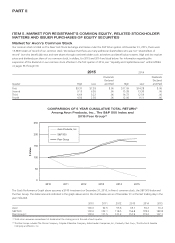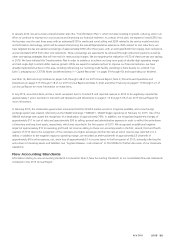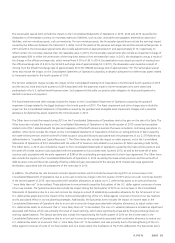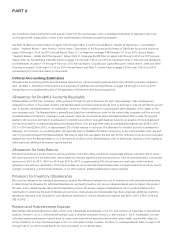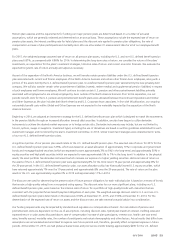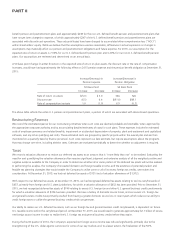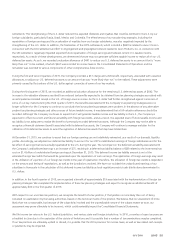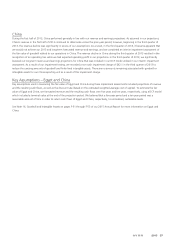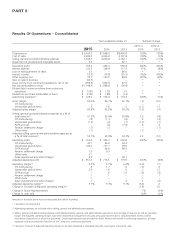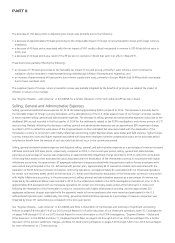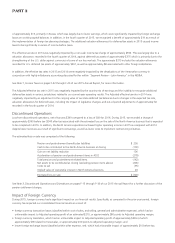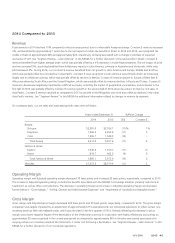Avon 2015 Annual Report Download - page 45
Download and view the complete annual report
Please find page 45 of the 2015 Avon annual report below. You can navigate through the pages in the report by either clicking on the pages listed below, or by using the keyword search tool below to find specific information within the annual report.Pension plan expense and the requirements for funding our major pension plans are determined based on a number of actuarial
assumptions, which are generally reviewed and determined on an annual basis. These assumptions include the expected rate of return on
pension plan assets, the interest crediting rate for hybrid plans and the discount rate applied to pension plan obligations, the rate of
compensation increase of plan participants and mortality rates. We use a December 31 measurement date for all of our employee benefit
plans.
For 2015, the weighted average assumed rate of return on all pension plan assets, including the U.S. and non-U.S. defined benefit pension
plans was 6.87%, as compared with 6.86% for 2014. In determining the long-term rates of return, we consider the nature of the plans’
investments, an expectation for the plans’ investment strategies, historical rates of return and current economic forecasts. We evaluate the
expected long-term rate of return annually and adjust as necessary.
As part of the separation of the North America business, we will transfer certain pension liabilities under the U.S. defined benefit pension
plan associated with current and former employees of the North America business and certain other former Avon employees, along with a
portion of the assets held by the U.S. defined benefit pension plan, to a defined benefit pension plan sponsored by the new privately-held
company. We will also transfer certain other postretirement liabilities (namely, retiree medical and supplemental pension liabilities) in respect
of such employees and former employees. We will continue to retain certain U.S. pension and other postretirement liabilities primarily
associated with employees who are actively employed by Avon outside of the North America business. Prior to this separation, our net
periodic benefit costs for the U.S. pension and postretirement benefit plans were allocated between Discontinued Operations and Global
and Other Expenses as the plan includes both North America and U.S. Corporate Avon associates. In line with this allocation, our ongoing
net periodic benefit costs within Global and Other Expenses are not expected to be materially impacted by the separation of the North
America business.
Beginning in 2014, we adopted an investment strategy for the U.S. defined benefit pension plan which is designed to match the movements
in the pension liability through an increased allocation towards debt securities. In addition, we also have begun to utilize derivative
instruments to achieve the desired market exposures or to hedge certain risks. Derivative instruments may include, but are not limited to,
futures, options, swaps or swaptions. Investment types, including the use of derivatives are based on written guidelines established for each
investment manager and monitored by the plan’s investment committee. In 2015, similar investment strategies were implemented in some
of our non-U.S. defined benefit pension plans.
A significant portion of our pension plan assets relate to the U.S. defined benefit pension plan. The assumed rate of return for 2015 for the
U.S. defined benefit pension plan was 7.25%, which was based on an asset allocation of approximately 70% in corporate and government
bonds and mortgage-backed securities (which are expected to earn approximately 3% to 5% in the long-term) and approximately 30% in
equity securities and high yield securities (which are expected to earn approximately 5% to 7% in the long term). In addition to the physical
assets, the asset portfolio has derivative instruments which increase our exposure to higher yielding securities. Historical rates of return on
the assets of the U.S. defined benefit pension plan were approximately 8% for the most recent 10-year period and approximately 8% for
the 20-year period. In the U.S. defined benefit pension plan, our asset allocation policy has historically favored U.S. equity securities, which
have returned approximately 7% over the 10-year period and approximately 8% over the 20-year period. The rate of return on the plan
assets in the U.S. was approximately negative 3% in 2015 and approximately 11% in 2014.
The discount rate used for determining the present value of future pension obligations for each individual plan is based on a review of bonds
that receive a high-quality rating from a recognized rating agency. The discount rates for our more significant plans, including our U.S.
defined benefit pension plan, were based on the internal rates of return for a portfolio of high-quality bonds with maturities that are
consistent with the projected future benefit payment obligations of each plan. The weighted-average discount rate for U.S. and non-U.S.
defined benefit pension plans determined on this basis was 3.92% at December 31, 2015, and 3.54% at December 31, 2014. For the
determination of the expected rate of return on assets and the discount rate, we take external actuarial advice into consideration.
Our funding requirements may be impacted by standards and regulations or interpretations thereof. Our calculations of pension and
postretirement costs are dependent on the use of assumptions, including discount rates, hybrid plan maximum interest crediting rates and
expected return on plan assets discussed above, rate of compensation increase of plan participants, interest cost, health care cost trend
rates, benefits earned, mortality rates, the number of participants and certain demographics and other factors. Actual results that differ from
assumptions are accumulated and amortized to expense over future periods and, therefore, generally affect recognized expense in future
periods. At December 31, 2015, we had pretax actuarial losses and prior service credits totaling approximately $296 for the U.S. defined
A V O N 2015 33
7553_fin.pdf 35



